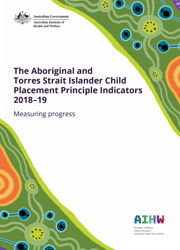Summary
The Aboriginal and Torres Strait Islander Child Placement Principle (ATSICPP) is a framework designed to promote policy and practice that will reduce the over-representation of Aboriginal and Torres Strait Islander children in the child protection system. This report brings together the latest state and territory data on 5 ATSICPP indicators that measure and track the application of the Placement and Connection elements of the framework.
The Appendix provides an overview of all of the draft ATSICPP indicators proposed for development in future.
Placement
The Placement element can be measured by determining the types of carers Aboriginal and Torres Strait Islander children in out-of-home care have been placed with, or more specifically, a carer’s relationship to the child.
1.1 Aboriginal and Torres Strait Islander children in out-of-home care placed with Aboriginal and Torres Strait Islander or non-Indigenous relatives or kin, or other Aboriginal and Torres Strait Islander carers.
Connection
The Connection element relates to support for Aboriginal and Torres Strait Islander children in out-of-home care to maintain or re-establish connections to their family, community, culture and country. This element is considered especially relevant for Aboriginal and Torres Strait Islander children placed with non-Indigenous carers.
2.1 Aboriginal and Torres Strait Islander children in out-of-home care placed with Aboriginal and Torres Strait Islander relatives or kin, or other Aboriginal and Torres Strait Islander carers
2.2 Aboriginal and Torres Strait Islander children in out-of-home care with cultural support plans
2.3 Aboriginal and Torres Strait Islander children who were reunified
2.4 Aboriginal and Torres Strait Islander children who were reunified and did not return to out-of-home care within 12 months.
Key findings are:
- About 18,000 Aboriginal and Torres Strait Islander children were living in out-of-home care at 30 June 2019 (a rate of 54 per 1,000).
- Nearly two-thirds (63%) of Aboriginal and Torres Strait Islander children in out-of-home care were living with Aboriginal and Torres Strait Islander or non-Indigenous relatives or kin or other Aboriginal and Torres Strait Islander caregivers.
- About 8,100 Aboriginal and Torres Strait Islander children in out-of-home care were required to have cultural support plans at 30 June 2019, and 77% of them had current, documented and approved cultural support plans, which include details such as the child’s cultural background and actions taken to maintain their connection to culture.
- Based on data from 6 states and territories:
- there were 4,700 Aboriginal and Torres Strait Islander children in out-of-home care during 2018–19 who were candidates for reunification with parents, family or former guardians, and 19% were reunified during the year. Children on long-term guardianship or custody orders are generally not considered to be candidates for reunification
- of the 820 Aboriginal and Torres Strait Islander children aged 0–16 who were reunified with family during 2017–18, 82% did not return to out-of-home care in the following 12 months.
1. Introduction
- The Aboriginal and Torres Strait Islander Child Placement Principle
2. The ATSICPP indicators
- What is the Placement element of the ATSICPP?
- What is the Connection element of the ATSICPP?
- How do we measure application of the Connection element?
- Data source and methods
- More information
Appendix: Additional draft ATSICPP Indicators
End matter: Acknowledgments; Abbreviations; Glossary; References



